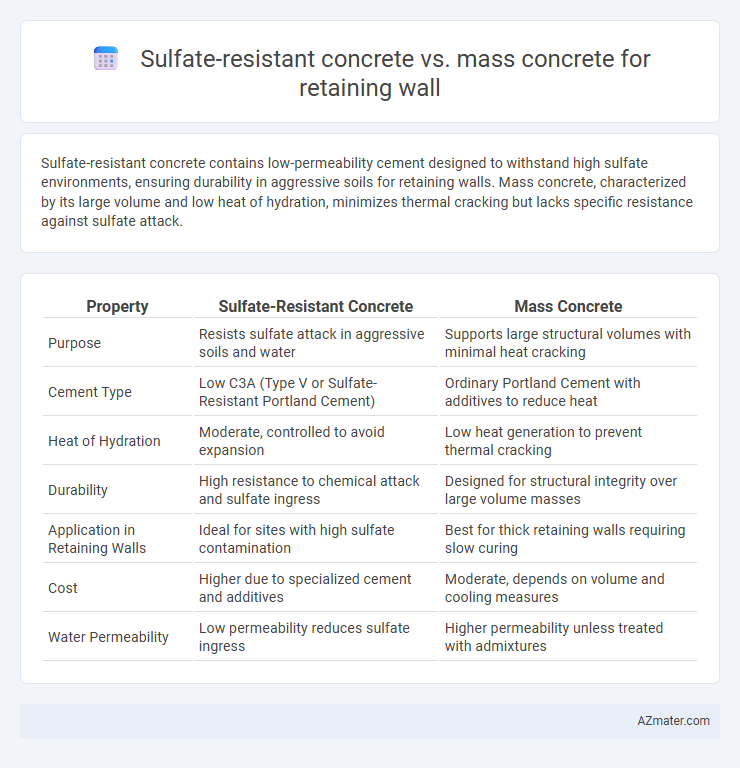Sulfate-resistant concrete contains low-permeability cement designed to withstand high sulfate environments, ensuring durability in aggressive soils for retaining walls. Mass concrete, characterized by its large volume and low heat of hydration, minimizes thermal cracking but lacks specific resistance against sulfate attack.
Table of Comparison
| Property | Sulfate-Resistant Concrete | Mass Concrete |
|---|---|---|
| Purpose | Resists sulfate attack in aggressive soils and water | Supports large structural volumes with minimal heat cracking |
| Cement Type | Low C3A (Type V or Sulfate-Resistant Portland Cement) | Ordinary Portland Cement with additives to reduce heat |
| Heat of Hydration | Moderate, controlled to avoid expansion | Low heat generation to prevent thermal cracking |
| Durability | High resistance to chemical attack and sulfate ingress | Designed for structural integrity over large volume masses |
| Application in Retaining Walls | Ideal for sites with high sulfate contamination | Best for thick retaining walls requiring slow curing |
| Cost | Higher due to specialized cement and additives | Moderate, depends on volume and cooling measures |
| Water Permeability | Low permeability reduces sulfate ingress | Higher permeability unless treated with admixtures |
Introduction to Retaining Walls and Concrete Types
Retaining walls require durable concrete types to withstand soil pressure and environmental conditions. Sulfate-resistant concrete is formulated to resist sulfate attacks, making it ideal for aggressive soil environments, while mass concrete offers volume and strength suitable for large retaining wall structures. Selecting the right concrete type ensures structural integrity and longevity based on soil sulfate content and wall dimensions.
Overview of Sulfate-Resistant Concrete
Sulfate-resistant concrete is specially formulated to withstand the chemical attack caused by sulfates commonly found in soil and groundwater, making it ideal for retaining walls exposed to aggressive environments. It uses Portland cement with minimized tricalcium aluminate content, often supplemented with supplementary cementitious materials like fly ash or slag to enhance durability and reduce permeability. Compared to mass concrete, sulfate-resistant concrete significantly improves the lifespan and structural integrity of retaining walls in sulfate-rich conditions by preventing expansive reactions that lead to cracking and deterioration.
Overview of Mass Concrete
Mass concrete for retaining walls is characterized by its large volume and low heat of hydration, which minimizes thermal cracking during curing. It provides excellent structural stability and durability, especially in environments not exposed to aggressive sulfate conditions. Compared to sulfate-resistant concrete, mass concrete offers cost-effective strength but requires careful temperature control and curing practices to ensure long-term performance.
Chemical Composition Differences
Sulfate-resistant concrete incorporates low C3A (tricalcium aluminate) content, typically less than 5%, to minimize chemical reactions with sulfate ions that cause expansion and deterioration. Mass concrete used in retaining walls often contains higher C3A levels since its primary focus is structural stability rather than chemical resistance. The reduced C3A in sulfate-resistant concrete enhances durability in aggressive sulfate environments, preventing damage common in conventional mass concrete.
Durability in Aggressive Environments
Sulfate-resistant concrete significantly enhances durability in aggressive environments by minimizing sulfate attack, which leads to expansion, cracking, and loss of strength common in mass concrete used for retaining walls. The use of low C3A cement clinker and supplementary cementitious materials in sulfate-resistant concrete mitigates chemical reactions with sulfates present in soil and groundwater. Mass concrete, while suitable for structural mass, often exhibits reduced durability under sulfate exposure without these specific resistance properties, resulting in increased maintenance and repair costs over time.
Structural Performance and Load Bearing
Sulfate-resistant concrete exhibits enhanced durability in aggressive soil environments, offering superior resistance to chemical attacks that can compromise the structural integrity of retaining walls. Mass concrete, characterized by its large volume and slower curing process, provides exceptional load-bearing capacity and stability under high compressive forces typical in retaining wall applications. The choice between sulfate-resistant and mass concrete hinges on balancing chemical resistance and load-bearing demands to ensure long-term performance in soil retention structures.
Thermal Management in Large Structures
Sulfate-resistant concrete is engineered to withstand aggressive sulfate environments, reducing chemical deterioration and enhancing durability in retaining walls exposed to sulfate-rich soils. Mass concrete generates significant heat during hydration, posing challenges in thermal management, especially in large retaining wall structures where temperature differentials can cause cracking. Employing sulfate-resistant concrete minimizes the risk of sulfate attack while incorporating cooling techniques and thermal control measures in mass concrete ensures structural integrity by mitigating thermal stresses.
Cost Analysis and Material Availability
Sulfate-resistant concrete, designed to withstand aggressive sulfate environments, typically incurs higher material costs due to specialized cement types like Type V Portland cement, impacting the overall budget for retaining wall construction. Mass concrete, often composed of standard Portland cement and aggregates in large volumes, usually offers cost advantages with more readily available materials, reducing procurement challenges. Evaluating local availability of sulfate-resistant cements versus conventional materials is critical for accurate cost analysis and project feasibility in retaining wall designs.
Construction Techniques and Challenges
Sulfate-resistant concrete for retaining walls requires precise mix design with low permeability cement types like Type V Portland cement to withstand aggressive sulfate-rich soils, demanding careful curing techniques to prevent early-age cracking. Mass concrete applications necessitate controlled heat management through cooling pipes or low-heat cement to mitigate thermal cracking risks due to exothermic hydration reactions within large volumes. Both types involve challenges in ensuring uniform compaction and curing, with sulfate-resistant concrete demanding stricter quality control to maintain durability against chemical attack.
Best Practices for Selecting Concrete for Retaining Walls
Selecting concrete for retaining walls involves prioritizing durability and environmental resistance, making sulfate-resistant concrete ideal in sulfate-rich soils to prevent chemical degradation and ensure long-term structural integrity. Mass concrete, characterized by low heat of hydration and minimized thermal cracking, suits large-scale retaining walls requiring substantial volume and thermal stability. Best practices include assessing soil sulfate levels, structural load requirements, and thermal conditions to choose between sulfate-resistant and mass concrete, optimizing performance and lifespan.

Infographic: Sulfate-resistant concrete vs Mass concrete for Retaining wall
 azmater.com
azmater.com